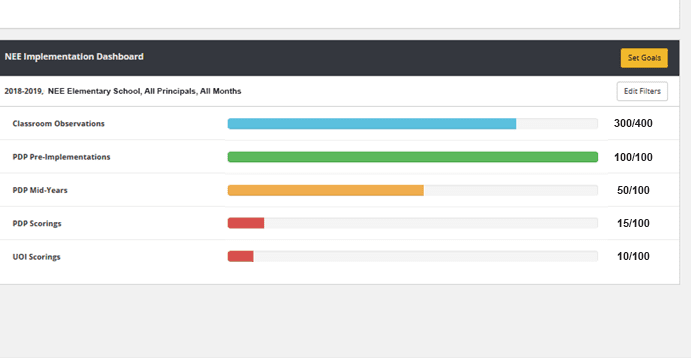The Importance of Reviewing Your Classroom Observation Data

It’s important to periodically review your NEE classroom observation data to measure progress toward meeting your building and district goals and make adjustments based on the data.
NEE recommends that each teacher be observed six to ten times over the course of the year for 10-15 minutes each time. Some districts require at least one full-period observation, so you would expect fewer observations per teacher in that case, though you should still expect some shorter walkthroughs to occur as well.
The importance of conducting observations and walkthroughs on a regular basis cannot be overstated. Being in classrooms regularly and giving regular feedback are essential elements to achieving instructional improvement. When you are in classrooms often, you have the benefit of gaining a more realistic picture of the instruction taking place over time. You better understand the context of the teaching, which allows you to offer better feedback and recognize anomalies. While evaluation “scores” might be given during these observations, the greatest value for instructional growth is in the feedback you offer. Simply put: Feedback works best when you give it regularly and effectively. (For more on feedback, see the 3 Golden Rules and 5-step Process to Giving Effective Feedback.)
Now is a good time to check your NEE observation goals and start to think about your plans for next school year. The following three questions can guide your analysis:
- How are you progressing toward your NEE implementation goals?
- Are principals meeting your expectations for observation frequency?
- Are you measuring classroom observation indicators that align with your school goals?
Let’s explore each of those questions in more detail.

How are you progressing toward your NEE implementation goals?
At the beginning of the school year, you set implementation goals within your NEE dashboard for the number of classroom observations (and potentially other evaluation measures) you expected to complete this year. This is an easy metric to view on your NEE dashboard when you first log in to the online system.
Although this is broad data to look at, it’s important to regularly monitor these status bars. If you are a principal and you’re not on track to meet your individual goals, you might think about whether you can reorganize priorities to get back on track or set new goals based on what you think you can accomplish for the remainder of the year.
If you’re a district administrator, you can look at this data from the perspective of the entire district or filter down to the building level. If your district-wide or building-level expectations are not being met, it’s time to have a conversation with principals to set clear expectations and, if necessary, support principals in reorganizing priorities to meet your expectations.
Are principals meeting your expectations for observation frequency?
To answer this question, open up your Building Activity and District Activity reports under the “Status Reports” menu in the NEE Data Tool.
To get an idea for how schools across the NEE system are doing with frequency, we recently dived into the data for all of our 280 school districts. During the 12 months beginning February 1, 2019, and ending January 31, 2020, there were 93,262 classroom observations completed for 27,501 individual teachers in NEE. On average, that comes out to 3.4 observations per teacher.
We also wanted to understand the number of observations, on average, each principal is completing. To determine that average, we divided 93,262 observations by 1,700, which is the approximate number of principals NEE trains each summer. The average came out to 55 observations per principal.
While this data is generalized and doesn’t take into account some nuances within NEE, these numbers give you a couple of points of reference as you explore your specific building or district data more deeply. Once again, measure the results reflected in this report against the expectations you have. If you’re part of NEE, there’s no doubt that classroom observations are a priority in your building or district, so does the data reflect that? Are you seeing enough observations to generate meaningful data?
Are you measuring classroom observation indicators that align with your school goals?
A final point in this discussion relates to the alignment of classroom observation indicators with your district and building goals. To further cement the importance of classroom observations, consider the alignment between what you are measuring during classroom observations and your school’s collective goals.
If the indicators currently being used are not aligned to your district or building goals, then it’s time to start a conversation to review the 27 NEE classroom observation rubrics available for you to use. This spring, start the review process around those teacher performance indicators and plan the needed changes (to be implemented at the start of the new data cycle) to improve the alignment and provide you with more useful real-time data.
If you already see alignment between your classroom observation indicators and your school’s goals, ask yourself a couple of additional questions:
- Are you using observation data to measure progress toward meeting your goals?
- Are you getting enough observations to gain an accurate measure in real-time that reveals or shows the needed growth?
We hope this discussion has helped you see that NEE can be used as a tool to assist you in systematically measuring progress toward shared goals at the district, building, and even classroom level. As a leader, it’s important to monitor and review your classroom observation data regularly and discover what it tells you about learning in your district and building. If your current data does not inform your goal progress and decisions, contact your NEE regional field support representative to talk about the changes that can be made so you can get the most out of your NEE data.
The Network for Educator Effectiveness (NEE) is a simple yet powerful comprehensive system for educator evaluation that helps educators grow, students learn, and schools improve. Developed by preK-12 practitioners and experts at the University of Missouri, NEE brings together classroom observation, student feedback, teacher curriculum planning, and professional development as measures of effectiveness in a secure online portal designed to promote educator growth and development.


